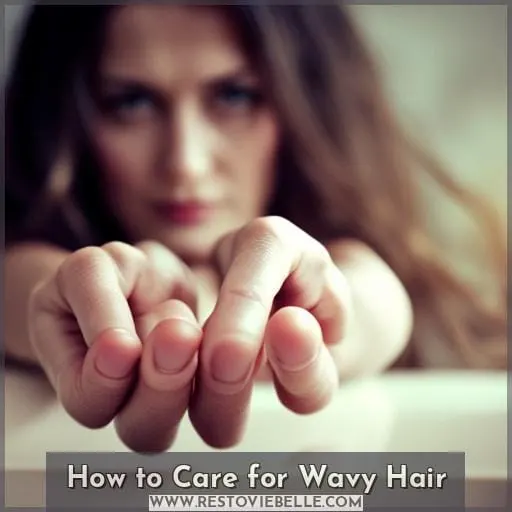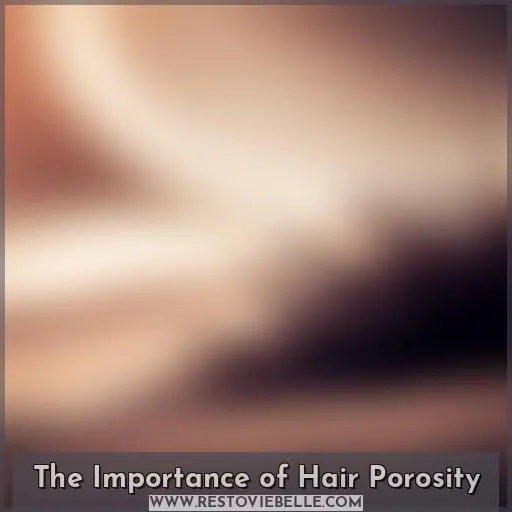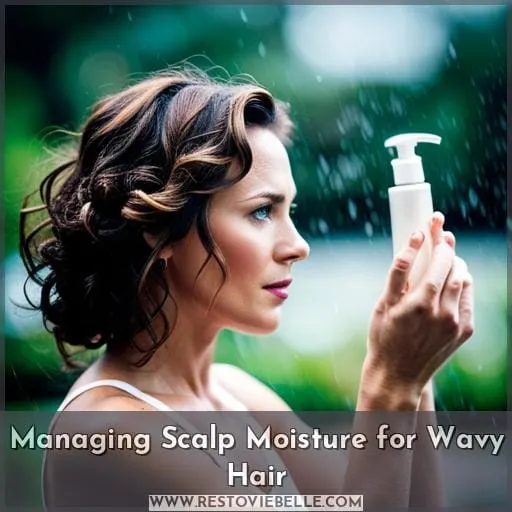This site is supported by our readers. We may earn a commission, at no cost to you, if you purchase through links.
 Imagine this: you’ve always believed your hair to be straight, but lately, you’ve started noticing some subtle waves.
Imagine this: you’ve always believed your hair to be straight, but lately, you’ve started noticing some subtle waves.
In this article, we’ll explore the signs and tests to determine if your straight locks have a hidden wave pattern. Get ready to embrace your true texture and discover how to care for those beautiful waves.
Table Of Contents
- Key Takeaways
- How to Determine if Your Hair is Wavy
- Different Types of Wavy Hair
- How to Care for Wavy Hair
- Understanding Hair Texture and Structure
- The Importance of Hair Porosity
- Managing Scalp Moisture for Wavy Hair
- Signs and Tests for Wavy Hair
- Recommended Products for Wavy Hai
- Frequently Asked Questions (FAQs)
- Conclusion
Key Takeaways
- Wavy hair falls between straight and curly in terms of texture and typically has medium porosity.
- Signs of wavy hair include hair drying with a slight wave, frizz, and volume at the roots.
- There are three main types of wavy hair: 2A waves, 2B waves, and 2C waves.
- Wavy hair can be prone to frizz and dryness, so it’s important to use lightweight products that enhance waves without weighing them down.
How to Determine if Your Hair is Wavy
To determine if your hair is wavy, follow these steps.
First, consider the texture of your hair. Wavy hair typically falls between straight and curly in terms of texture.
Next, assess the porosity of your hair. Wavy hair tends to have medium porosity, meaning it absorbs and retains moisture moderately well.
You should also take into account the density of your strands. Wavy hair usually has a moderate density with neither too many nor too few strands per square inch.
Lastly, evaluate the elasticity of your locks. If you find that your waves bounce back after being stretched or manipulated without losing their shape completely, then chances are you have wavy hair.
By considering factors such as texture, porosity,density,and elasticity,you can confidently determine if what you thought was straight actually possesses beautiful waves waiting to be embraced.
Different Types of Wavy Hair
Now let’s talk about the different types of wavy hair.
Wavy hair can vary in texture and pattern, with each type having its own unique characteristics.
The three main types are:
- 2A waves, which have a soft ‘S’ shape;
- 2B waves, which are more defined with some frizz and poofy ends;
- 2C waves, which still maintain a prominent S pattern but can resemble the first curly hair type (3A).
Understanding your specific wavy hair type will help you choose the best products and styling techniques for your locks.
2A Wavy Hair
If your hair dries with a soft ‘S’ shaped pattern and lacks volume, you may have 2A waves.
To care for your 2A wavy hair, use products specifically designed for this hair texture.
Opt for lightweight formulas that enhance the natural wave pattern without weighing it down.
Consider getting a one-length cut to maintain the shape of your waves.
2B Wavy Hair
Now let’s dive into the characteristics of 2B wavy hair, which is a type of wavy hair that has a more defined ‘S’ pattern and tends to be prone to frizz and poofy ends.
To care for your 2B waves, choose products specifically formulated for wavy hair texture, opt for layered cuts to enhance the natural wave pattern, and use styling techniques that reduce frizz.
2C Wavy Hair
Now let’s talk about 2C wavy hair, which has a prominent S pattern and can share similarities with the first curly hair type, 3A.
To care for your 2C waves, use products specifically designed for wavy hair and follow a proper routine.
Experiment with different styling techniques to enhance your waves and consider factors like porosity when choosing products.
How to Care for Wavy Hair
To care for your wavy hair, it’s important to choose the right products and follow some styling tips.
- Look for texturizing or wave defining products that enhance your waves without weighing them down.
- Avoid heavy products that can flatten your waves.
- Opt for a haircut with one-length layers to maintain the shape of your waves.
Choosing the Right Products
To care for your wavy hair, choose the right products that cater to its unique needs.
- Opt for lightweight products: Wavy hair tends to be more prone to frizz and can easily become weighed down by heavy formulas. Look for lightweight styling creams or mousses that provide hold and definition without sacrificing volume.
- Seek frizz control: Frizz is a common challenge with wavy hair, so prioritize products that offer anti-frizz properties. Serums or leave-in conditioners with smoothing ingredients like argan oil can help tame unruly strands.
- Enhance shine: Wavy hair has the potential to showcase beautiful natural shine when properly cared for. Choose styling sprays or finishing oils infused with ingredients like jojoba oil or vitamin E, which will add luster and enhance the overall appearance of your waves.
Styling Tips for Wavy Hair
To care for your wavy hair, use texturizing or wave defining products and avoid heavy products that weigh down your waves. These will help enhance the natural texture of your hair and define those beautiful waves.
For 2A waves, opt for a one-length cut to keep it looking sleek.
If you have 2B or 2C waves, adding layers can add more movement and bounce to your hair.
Consider booking an appointment with Belle Amour for personalized styling tips specific to your wavy hair type.
Understanding Hair Texture and Structure
Understanding the texture and structure of your hair is essential in determining whether your straight hair might actually be wavy.
Hair texture refers to the diameter of each individual strand, while hair structure refers to characteristics such as density, thickness, elasticity, moisture level, and oiliness.
- Hair density refers to how many strands are on your scalp. This can range from low density (thin or sparse) to high density (thick or abundant).
- Hair thickness relates to the size of each individual strand – fine hair has a smaller diameter while coarse hair has a larger diameter.
- Hair elasticity determines how well it stretches without breaking and then returns back to its original shape. If you have highly elastic hair that easily forms curls when wet but appears straight when dry, this could indicate wavy tendencies.
- Hair moisture levels refer to how well your strands absorb and retain water. High porosity means that your cuticles easily absorb moisture but also release it quickly whereas low porosity means that they resist absorbing water.
- Lastly, understanding if you have an oily or dry scalp can help determine which products will work best for managing any potential concerns related specifically with regards maintaining proper care for waves.
The Importance of Hair Porosity
Knowing your hair’s porosity is essential for understanding how it absorbs and retains moisture.
- Porosity Scale: Hair porosity can be categorized into three levels – high, normal, and low. This scale determines how easily your hair absorbs moisture.
- Hair Porosity Test: Conducting a simple test can help determine your hair’s porosity level. One popular method involves placing a strand of clean, dry hair in water and observing its behavior to identify if it floats (low), sinks immediately (high), or slowly sinks after some time (normal).
- High Porosity Hair Care: If you have high-porosity hair, you need to focus on sealing in moisture by using products that provide hydration and minimize protein loss.
- Low Porosity Hair Care: If you have low-porosity hair, you need to focus on moisturizing your hair without weighing it down.
Managing Scalp Moisture for Wavy Hair
To effectively manage scalp moisture for wavy hair, it’s important to address two common concerns:
- Dealing with an oily scalp
- Combating dryness.
An oily scalp can lead to issues such as dandruff and buildup, while a dry scalp can cause itching and flakiness. By understanding these problems and implementing targeted solutions, you can maintain a healthy balance of oil and water on your scalp for optimal hair health.
Dealing With Oily Scalp
If you have wavy hair, dealing with an oily scalp is a common challenge that can affect the overall health and appearance of your waves.
To manage scalp moisture for wavy hair, it’s important to choose the right products such as oily scalp shampoo and conditioner specifically formulated to control excess oil. Additionally, incorporating remedies like regular cleansing and avoiding heavy styling products can help keep your waves looking fresh and vibrant.
| Oily Scalp Causes | Oily Scalp Products |
|---|---|
| – Overactive oil glands | – Oily scalp shampoo |
| – Hormonal imbalances | – Oily scalp conditioner |
| Oily Scalp Remedies | |
| —————— | ——————– |
| – Regular cleansing | |
| – Avoiding heavy styling products |
Combating Dry Scalp
To combat dry scalp and manage scalp moisture for wavy hair, you can take several effective steps.
Firstly, make sure to use a gentle shampoo that doesn’t strip away natural oils from your scalp.
Additionally, incorporate a hydrating conditioner into your hair care routine to replenish moisture.
If you’re dealing with flaky or itchy scalp, look for products specifically designed to address these issues such as anti-dandruff shampoos or those formulated for seborrheic dermatitis.
Lastly, avoid excessive heat styling which can further contribute to dryness and sensitivity on the scalp.
Signs and Tests for Wavy Hair
Wondering if your straight hair might actually be wavy? Look out for signs such as:
- Your hair drying with a slight wave
- Frizziness
- Volume at the roots
Another way to test is by trying to straighten your hair with heat – if it doesn’t stay straight for long, it could be a sign of natural waves.
Signs You May Have Wavy Hair
Looking for signs that indicate you might’ve wavy hair? There are a few key indicators to look out for.
First, if your hair is wavy when wet but dries straight, it’s likely that you have wavy hair.
Additionally, if you notice a lot of frizz or your hair looks puffy or flicks out at the roots, these are common characteristics of wavy hair.
Finally, if heat styling tools can’t make your hair completely straight, this could be another sign of its natural waviness.
Understanding these signs can help guide your choice in products and care routine for managing and enhancing the shape and texture of your waves.
1. Hour Test for Wavy Hair
To determine if your hair is wavy, you can conduct a 1-hour test to observe how it behaves and dries during that time.
Start by washing and conditioning your hair as usual.
Then, let it air dry without manipulating or styling it in any way.
Pay attention to how the strands form waves or curls as they dry.
If you notice a slight wave pattern developing, this indicates that your hair has some natural texture and may be wavy rather than straight.
Recommended Products for Wavy Hai
For wavy hair, it’s important to use the right products that enhance your waves and keep them looking their best.
-
Leave-in Conditioner:
A leave-in conditioner helps hydrate and define your waves without weighing them down. Look for a lightweight formula that adds moisture while reducing frizz.
-
Mousse:
Mousse is a great option for adding volume and enhancing the natural texture of your waves. Apply it to damp hair, scrunching from roots to ends, then let it air dry or diffuse with a blow dryer.
-
Salt Spray:
Sea salt spray can give your waves beachy texture and definition. It adds grip so you can create effortless-looking tousled waves by spraying onto damp or dry hair.
-
Curl Cream/Gel:
Curl cream or gel helps define and hold your curls in place throughout the day. Gently scrunch these styling products into wet or damp hair before allowing it to air dry.
By using these recommended products specifically formulated for wavy hair, you can enhance your natural wave pattern, wash away any frizz, and achieve beautiful, defined hairstyles.
Frequently Asked Questions (FAQs)
Can you have both straight and wavy hair?
Yes, it’s possible to have both straight and wavy hair.
Some individuals may have sections of their hair that are naturally straight while other parts exhibit a waviness or curl pattern.
Can wavy hair become straight over time?
Over time, wavy hair can become straight due to various factors such as:
- Hormonal changes
- Heat styling
- Chemical treatments
Embrace the natural beauty of your waves or explore different styling techniques for a versatile look.
Is it possible for hair to change from straight to wavy or vice versa?
Yes, it’s possible for hair to change from straight to wavy or vice versa.
Changes in hormone levels, genetics, and styling techniques can all contribute to alterations in the natural texture of your hair over time.
How can I enhance the waves in my hair?
Looking to enhance the waves in your hair?
Try using texturizing or wave defining products.
Avoid heavy products that weigh down waves and consider a haircut with layers for added volume and definition.
Are there any hairstyles that work best for wavy hair?
For wavy hair, opt for hairstyles that embrace the natural texture.
Consider:
- Loose waves with a middle part
- Beachy waves with a side-swept bang
- Tousled updos
Play around and find what works best for you!
Conclusion
To conclude, it’s time to embrace the possibility that your straight hair might actually have a hidden wave pattern.
By understanding the signs and tests for wavy hair, you can determine your true hair texture and learn how to care for those beautiful waves.
From choosing the right products to managing scalp moisture, there are various ways to enhance and embrace your wavy hair.
So, say goodbye to straight hair and hello to your newfound wavy locks! Embrace the waves and enjoy the journey of discovering your true hair texture.














